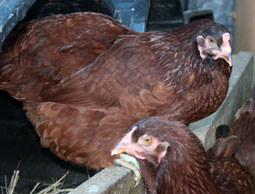
 Photo by Sue Weaver Our Buckeye hens give us medium-sized, lightly tinted eggs. |
Last week, I told you some of the weird things Uzzi and I learned about eggs. We also learned some things that aren’t so crazy.
Chickens lay all sizes of eggs, from peewee weighing 1.25 ounces each to jumbo at 2.5 ounces each. The shell accounts for about 12 percent of the weight of a large egg. Pullets start by laying smallish eggs, but as a hen ages, her eggs get bigger. She also lays eggs of a specific color, not pink-tinted one day and deep, dark brown the next. Our Buckeyes’ eggs are medium in size and range from lightly tinted to medium brown. (Camilla lays the lightly tinted eggs.)
Colored eggs happen when pigment is added during shell formation. A thin layer of brown pigment is added to a brown egg’s bloom. Also called its cuticle, bloom is the last layer of shell deposited before a egg is laid. Blue pigment gets deposited in every layer, so blue eggs are colored all the way through. Green eggs are blue-shelled eggs with a brown bloom. White eggs aren’t pigmented at all.
You can tell how old an egg is by placing it in a container of water. A fresh egg sinks and rests horizontally on the bottom. A two- to three-week-old egg stands vertically at the bottom, big end up. Really old eggs float.
If you can’t remember if you boiled an egg, spin it; boiled eggs spin really fast, fresh eggs slowly wobble.
What chickens eat affects the taste of their eggs and color of their yolks. The rich, yellow color most humans prefer comes from xanthophyll, a yellow-orange pigment found in green plants and yellow corn. Acorns or shepherd’s purse can turn yolks green, and silage or cottonseed meal make reddish- or blackish-green yolks. (Yuck!)
Finally, not every egg a hen lays is “normal,” though if they’re fresh, they’re still safe to eat. Here are some weird things you might find in your eggs:
- Blood spots don’t mean an egg is fertile. They happen when a small blood capillary ruptures and a spot of blood is released along with the yolk. They sometimes show up in a pullet’s first few eggs and again when she’s an old hen. As an egg with a blood spot ages, the blood spot becomes paler so a bright-red blood spot means an egg is super-fresh.
- Brown, tan, gray or white spots near the yolk are called meat spots. Sometimes they’re blood spots that changed color, and sometimes they’re bits of tissue from the hen’s reproductive tract.
- Occasionally, a pullet lays an egg with no yolk at all. One of our Buckeyes did that last week. These are called dwarf eggs or wind eggs. In olden times, people thought they were laid by roosters.
- Sometimes eggs have two or more yolks. That happens when ovulation occurs super quickly and one yolk is joined by a second yolk. According to Gail Damerow, a chicken expert who wrote Storey’s Guide to Raising Chickens, the largest number found in a single egg is nine yolks.
- Once in a great while, a hen might lay a double-shell egg. This occurs when an egg that’s almost ready to be laid reverses direction and gets a new layer of egg white and another shell. The Guinness World Record for the heaviest egg weighed 1 pound and had a double yolk and two shells. That was some egg!




